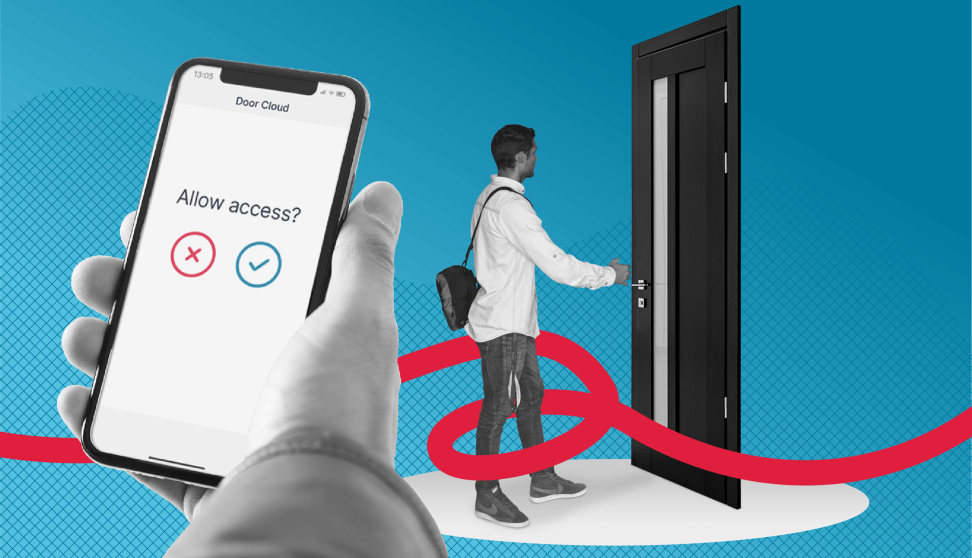What is cloud access control?

Every organization needs some type of access control, either to track who is entering and leaving the office, or to restrict physical access to certain parts of the building.
For this reason, access control is an essential component of an organization's security. There are three basic types of access control:
- locks and keys (analog),
- on-premises access control,
- and cloud-based access control.
With a cloud access control system, you can manage entrances remotely, from anywhere in the world; all you need is access to the Internet. With a mobile or desktop app, you can manage who has access to entrances, and you also have the ability to grant or revoke access instantly.
The software is referred to as cloud-based because it is hosted in the cloud rather than on-premises servers (physically located in the company's building).
This provides many benefits, such as lower initial investment, lower maintenance costs, on-demand availability, scalability and regular updates.
Cloud access control is the most advanced, sophisticated, secure and affordable type of access control.
How does cloud access control work?
The main advantage of a cloud-based access control system is that you can manage access or open doors from anywhere. As an administrator, you have access to a web and mobile application that allows you to manage doors remotely online.
The following are some of the many features available to you with the administrative dashboard:
- Identity management
- Access management - Granting or revoking access to entrances
- Open or lock doors
- Initiate a whole building lockdown
- See data and statistics on who entered or exited the premises
- Instantly see notifications and alarms via mobile phone
On the other hand, those granted access - employees, visitors, guests, etc. - can use their mobile phone to open doors; alternatively, other types of readers are also available (card, bracelet, fob, keypad...).
The major benefit of cloud access control is that doors can be opened with a mobile phone, so there isn’t any need to carry additional physical objects.
In the wake of COVID-19, limiting usage to one’s own cell phone is an important measure to help prevent the spread of pathogens. The trend of handling business infrastructure is such way is called the Low-Touch Economy.
So how does cloud access control work? It's simple. The software (database, logic) is hosted in the cloud and can be accessed from anywhere: administrators can use a mobile or web app, and end users can simply use their mobile phones to open doors (with an app, key link, etc.).
Near the door is a device that connects the card reader and drives the electric lock. This device may be some kind of smart lock or door controller, utilizing an internet connection, either wired or wireless.
The advantages of cloud access control for end users
Compared to traditional on-premises installations, cloud-based software solutions have become the industry standard over the past decade in almost every software category.
A possible exception is the case of large enterprises which can afford IT teams to constantly handle security, updates, administration, etc., while maintaining a complex infrastructure of servers, networks, and the like. It is also true, however, that even enterprise customers are increasingly leaning toward hybrid (a combination of cloud and on-premises) solutions.
There are many advantages to opting for cloud access control over expensive on-premises installations. The key benefits of a cloud-based access control solution are:
- You can access the web app regardless of which OS or browser you use.
- You can access the software from almost anywhere, all you need is an internet connection.
- New features, security measures and other updates are all applied automatically.
- All data and management options are centralized and can be backed up easily.
- Initial costs are significantly lower.
- The cloud solution easily scales up as the business grows.
- User experience is generally much better than with on-premises solutions.
- The access control system can be connected with other applications via APIs.
- Multiple locations, even on different continents, can be supported easily.
What about disadvantages? There are some smaller potential disadvantages, such as having fewer options for customization, and potential security risks if good practices for cloud solutions aren’t followed.
Any risks can, however, be easily mitigated, and that’s why cloud-based access control is becoming increasingly more popular.
The advantages of cloud access control for integration partners
Just as cloud access control offers many benefits for end users, it also provides significant benefits for integration partners.
Not only does it open up new sales opportunities, but the initial setup is much easier, configurations and updates can be done remotely, and the user experience with cloud services is typically much better, meaning faster onboarding and less need for active support.
Cloud access control saves integration partners time and money. That means better margins and less maintenance, not to mention recurring revenue that grows exponentially over the long term as new customers join the existing customer base.
Are you interested in adding cloud access control to your product portfolio? Check out our Cloud Partner Program.




